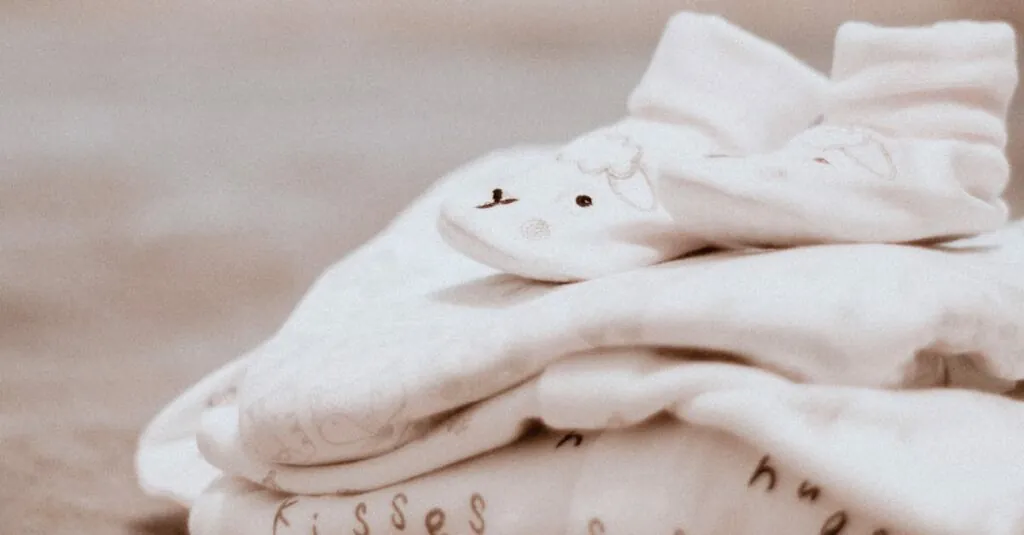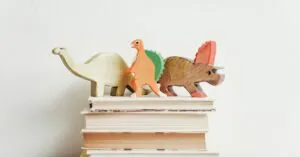Table of Contents
ToggleWhen it comes to dressing babies, parents often find themselves in a sock conundrum. Do those tiny feet really need socks? After all, they’re not just adorable fashion statements; they’re also a source of endless debate among caregivers. One minute, it’s all about warmth and comfort, and the next, it’s a battle against those pesky little socks that seem to vanish into thin air.
Understanding Baby Footwear
Baby footwear includes a variety of options, from socks to booties and shoes. With babies growing rapidly, parents often wonder about the best choices for their little ones’ feet. Socks serve both aesthetic and functional purposes, providing warmth and a sense of style. Many parents find it cute to dress their infants in colorful or themed socks, enhancing their outfits.
When considering warmth, keeping a baby’s feet warm can promote overall comfort. Cold feet might disrupt sleep or cause fussiness. Research indicates that babies do lose heat through their extremities, so warm footwear may play a role in maintaining a comfortable body temperature. Sleek booties or socks that fit snugly can help retain the necessary warmth.
Socks can also prevent moisture buildup and irritation. The right materials, such as cotton or bamboo, allow breathability while keeping feet cozy. Parents might choose socks with elastic grips that minimize slipping off. Such features can reduce the likelihood of losing footwear while enhancing convenience.
As babies begin to crawl or walk, selecting appropriate footwear becomes crucial. Soft-soled shoes or booties can provide support without restricting movement. Footwear needs to fit well, with adequate room for toes to wiggle. Poorly fitting socks or shoes can lead to discomfort, so sizing must be carefully considered.
Navigating baby footwear requires balancing style, comfort, and practicality. Choosing the right accessories helps keep babies comfortable while adding charm to their outfits.
The Importance of Keeping Baby’s Feet Warm
Keeping a baby’s feet warm plays a vital role in their overall comfort and health. Babies lack the ability to regulate their body temperature effectively, making it crucial to pay attention to their feet.
Factors Influencing Temperature Regulation
Factors that influence temperature regulation include the baby’s age, activity level, and environment. Age affects body fat levels, with newborns often having less insulation. Activity levels also influence warmth; active babies might generate heat, while inactive ones may feel cooler. The surrounding environment has a significant impact; cold rooms or drafts can lead to chilling. Parents should monitor these factors to ensure their little ones stay warm and comfortable.
Risks of Cold Feet in Babies
Cold feet in babies can pose several risks. Cold extremities may indicate overall body temperature drops, increasing the chance of hypothermia. Feet that remain cold for prolonged periods may lead to discomfort, irritability, and difficulty in sleeping. Additionally, circulation issues can arise, affecting foot health. Parents must prioritize warmth to avoid such risks and promote a cozy atmosphere for their babies.
When to Use Socks for Babies
Understanding when to use socks can help parents keep their babies comfortable. Different stages of development influence the need for socks.
Newborns vs. Older Infants
Newborns particularly benefit from socks due to their inability to regulate body temperature. Soft cotton or bamboo socks will provide the necessary warmth. Older infants, meanwhile, may not require socks indoors as they become more mobile. Movement often increases circulation, allowing for natural warmth. Selecting appropriate socks for older infants should prioritize fit and breathability to accommodate their active lifestyles.
Environmental Considerations
Temperature and environment play crucial roles in deciding when to use socks. In cooler climates, socks become essential for maintaining warmth during outdoor excursions. Conversely, in warmer settings, parents might opt for lightweight, breathable socks to prevent overheating. Indoor environments should also be considered; fluctuating temperatures may necessitate socks for warmth. Ultimately, monitoring the baby’s response to the environment guides the decision on whether to keep socks on or not.
Alternatives to Socks
Parents can explore various alternatives to socks for their babies. These alternatives can offer similar benefits in terms of warmth and comfort.
Booties and Slippers
Booties and slippers serve as stylish options for little feet. Soft-soled booties provide warmth while promoting flexibility. Material choices vary from cotton to wool, ensuring breathability and coziness. Many designs include non-slip soles for added safety as babies begin to explore. Slippers often feature adjustable closures, allowing for a snug fit that keeps them securely in place. Parents should consider both functionality and aesthetics when selecting these options.
Going Without Socks
Going without socks can also be a practical choice for babies. As mobility increases with crawling and walking, leaving feet bare may enhance sensory development. Some babies feel comfortable without anything on their feet, especially in warmer environments. Safe surfaces like soft rugs or carpet can provide adequate protection. Parents should assess the room temperature and their baby’s comfort level to determine if sock-less options are suitable. Monitoring the baby’s feet regularly ensures warmth and prevents discomfort.
Deciding whether babies need socks involves balancing warmth comfort and practicality. Parents should consider their baby’s age activity level and the surrounding environment when making this choice. While socks can provide essential warmth for newborns and infants in cooler climates they may not be necessary for older babies who are more mobile.
Alternatives like booties and slippers can also offer comfort and style while promoting flexibility. Ultimately it’s about monitoring the baby’s needs and ensuring their feet stay cozy and protected. By making informed decisions parents can keep their little ones comfortable while embracing their unique style.






